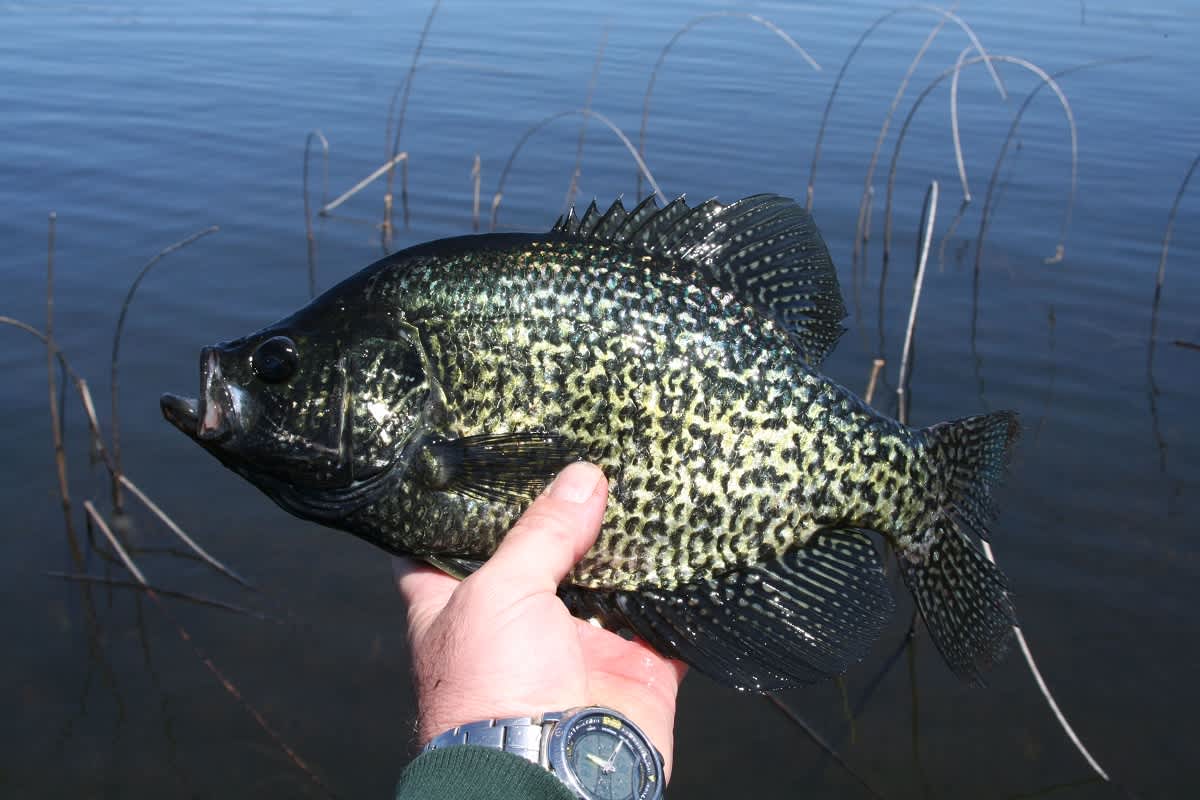On the Hunt for Early Spring Crappies
Bernie Barringer 04.25.14

Crappies are some of the first fish available to the angler in the spring. Take this angler’s advice for a stealthy approach to put more crappies in your frying pan this month.
Early spring crappies can be easy to find, but they can be quite hard to catch. Many an angler has found a group of crappies sunning in a shallow bay, only to see them scatter like drug addicts at the sight of a police badge when a lure is thrown into their midst. A much more stealthy approach is necessary. In fact, to be consistently successful, it needs to be more like hunting than it is fishing. You could call it “spot-and-stalk” crappie fishing!
Here in Minnesota, I start looking for crappies as soon as the ice goes off. The spring sunshine warms shallow bays quickly, especially those with dark mud bottoms. The dark bottoms absorb sunlight and in the right conditions, can warm up as much as eight to 10 degrees per day. These are the places the crappies will appear first. You may find them there in as little as a week following ice-out—but they are not very active at this time. They become much more active when the water temperature reaches 60 degrees. You don’t have to wait for waters that warm, all you have to do is find the warmest water available and the crappies will be there.

You must ease around these shallow bays in stealth mode until you see crappies. They will often be in loose groups right at the surface. They are putting the finishing touches on their pre-spawn reproductive system by basking in the warm water. The fish you find sunning themselves are difficult to catch, so I wait until they are in a better position—and they will be in a feeding mood sometime during the day.
The easier ones to catch will be associated with some sort of cover. Look for them around fallen trees, lily pad root wads, old reeds and bulrushes, stumps and brush. These are the fish that will make your fish fry a success. Crappies in these situations are very spooky. It can be difficult to move in close enough to see them without spooking them, but don’t worry. If they bolt out of the area at your approach, they will not go far, and they will be back within a few minutes. Leave the area and then move back in quietly a half-hour later; now that you know where they are you do not have to run right up on them. Just get close enough to see them.
Once you have located a school of crappies to fish, you have to be ready with the right bait and present it properly. It’s hard to beat a small, lively minnow suspended below a small bobber, a small split shot sinker, and a #8 hook with a small minnow.
The key is to get the bait in position with as little disturbance as possible. Often, you must cast beyond the fish and then slowly draw your offering nearer to yourself, right towards the waiting crappie. In many cases you need that minnow to be wiggling within six inches of the crappie’s nose or you are not going to get bit. This is finesse fishing to the extreme. You will earn every fish you catch and sometimes you will just have to abort the effort in frustration when a particular fish simply will not yield to the temptation. Move on to the next one.

The slip bobber is an important component of this system. Crappies rarely feed down—they like to bite things that are right at their level or slightly above. A slip bobber allows you to move the bobber stop up or down to get the bait right at the exact level; I find myself moving it often.
I use a long rod spooled with four-pound monofilament in most cases. My favorite crappie rig for crappie hunting is a nine-foot medium action rod with a fast tip that is actually made for steelhead fishing. The extra length helps you reach out and dabble at those fish that would be out of reach with a shorter rod. In some cases, you cannot cast, you must use a pendulum type swing of the rod tip to carefully drop your bait right in front of a fish. Often, you are reaching out and dropping the bait into an opening in the cover.
There are cases when I go to a more stout setup. Sometimes these crappies will be tucked in tight to last year’s dying reeds. Some people call them pencil weeds, I suppose in most cases they are some form of bulrush. They do offer the vertical cover that crappies like to spawn in, but it is hard to get them extracted once they are hooked. In this case I use a non-stretch line like FireLine so I can wrestle them immediately to the surface and swing them right in the boat. If you give them a fighting chance, they will tangle in the rushes and you will lose a large percentage of them. Once again, I am using a nine-foot rod with a good spine so I can lift even a 13- to 14-inch crappie right out of the cover.
As soon as the ice begins to loosen its grip on the waters in your area, it’s time to start thinking about crappies. There is something about catching early spring crappie that appeals to just about everyone. Maybe it’s the fact that they are superb table fare. Maybe it’s the challenge of the hunt. Or maybe it’s the opportunity to get in on the first great fishing action of a new spring season. Choose whichever reason you like as your favorite—if you put them all together, you have some of the finest fishing fun of the year!
Follow Bernie’s bowhunting adventures on his blog, bowhuntingroad.com.

